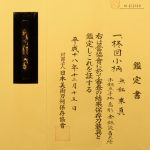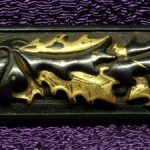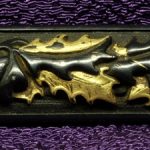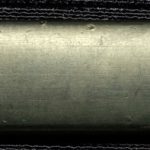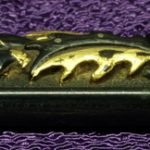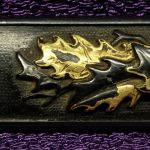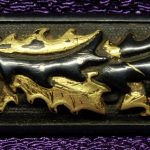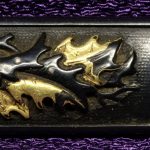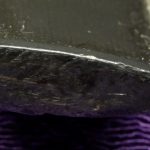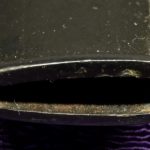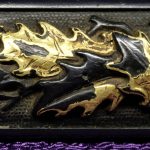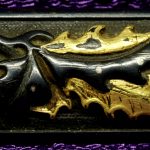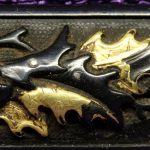GOTO JOSHIN / 3RD GOTO MASTER / NBTHK HOZON
KO-GOTO JOSHIN
The mainline Shirobei branch of the Goto family stands by itself in the history of soft metal fittings. Its founder is Yujo, who was likely born in Mino in 1440 and assimilated the various traditions of the time. He worked for the Ashikaga shogun Yoshimasa, and developed a typical style which he handed down to his son Sojo and would form the basis for house carving – iebori – for the rulers of Japan.
Ko-Goto Joshin
Goto Joshin was born as Shirobei Yoshihisa in Eisho 9 (1512). He was the first son of Goto Sojo, the 2nd main line master. He worked for the 12th and 13th Ashikaga shoguns Yoshiharu and Yoshiteru, and received the rank of Hogen. Joshin was also a bushi and fought on the battlefield, where he died in 1562 at the age of 51. His son would take up the name Kojo and continue the line as the 4th mainline master. Joshin’s work is a bit different from the generations coming before and after him, and is usually deeply carved and sometimes in large proportions.
The first three generations of the main line, Yujo, Sojo, and Joshin took their names after entering the priesthood and did not sign their work. We generally do not see signatures until the later generations of this school.
The work of the third master, Joshin (Yoshihisa), has been very much appreciated on account of its high relief. He was the son of Sojo, and lived from 1511-1562. The work is far bolder than that of his predecessors. He is known to have signed some of his work.
-Alexander Mosle
Though Mosle claimed some of his work was signed, there are not any signatures that have been accepted by the NBTHK for Joshin. The habit of signing work occasionally is something that comes several generations after Joshin, and it was not until the middle of the Goto line that work was consistently signed. The reason for this is generally because the main line of Goto were court artists, making objects for Shoguns and high ranking persons. Signing your name to an item is a mark of pride, and though today we think of brands having prominent labels for display, this was not at all the thought when making items for the military aristocracy.
The work of the first four Goto artists is restricted to the small fittings, kogai, kozuka and menuki, sometimes in sets of mitokoromono. Popular themes included dragons and shishi, which reflected themes of power and majesty and well suited the kinds of top level blades on which they would be placed. We tend to see these themes in gold on kozuka and kogai, placed on black shakudo nanako ground. We collectively refer to them as Ko-Goto, which is a term referred to for pre-Momoyama Goto work. This term I have seen used with a bit of flexibility, either to denote the first three generations, or the first five. The fifth generation Tokujo however is the first to make tsuba, and also he developed chemical plating processes that were used in place of the mechanical riveting processes of the older generations. As well his work is aligned with the Momoyama period, and so I think this is the logical place to separate the groups.
When it is remembered that the punching tool was guided solely by the hand and eye,and that three or more blows of the mallet had to be struck for every dot, some idea may be formed of the patience and accuracy needed to produce these tiny protuberances in perfectly straight lines at exactly equal intervals and of absolutely uniform size, so that a magnifying glass can scarcely detect any variation in their order and size. Nanako disposed in straight parallel lines has always ranked at the head of this kind of work.
The mainline Shirobei branch of the Goto family stands by itself in the history of soft metal fittings. Its founder is Yujo, who was likely born in Mino in 1440 and assimilated the various traditions of the time. He worked for the Ashikaga shogun Yoshimasa, and developed a typical style which he handed down to his son Sojo and would form the basis for house carving – iebori – for the rulers of Japan.
Goto Joshin was born as Shirobei Yoshihisa in Eisho 9 (1512). He was the first son of Goto Sojo, the 2nd main line master. He worked for the 12th and 13th Ashikaga shoguns Yoshiharu and Yoshiteru, and received the rank of Hogen. Joshin was also a bushi and fought on the battlefield, where he died in 1562 at the age of 51. His son would take up the name Kojo and continue the line as the 4th mainline master. Joshin’s work is a bit different from the generations coming before and after him, and is usually deeply carved and sometimes in large proportions.
The first three generations of the main line, Yujo, Sojo, and Joshin took their names after entering the priesthood and did not sign their work. We generally do not see signatures until the later generations of this school.
The work of the early Goto masters was something that was reserved for daimyo, shoguns and the imperial court, and the value of this work was beyond the means of an average bushi to have for their sword. Old books from the 1900s in the English language frequently state that the work of the Goto masters is rare and almost non-existent outside of Japan where they have been preciously kept and handed down through generations. With the rise in collecting of Japanese samurai artifacts worldwide and the ability for collectors to find items on the internet, we have become the first generation to have unrestricted access to these wonderful objects.
To date there are 82 items that passed Juyo attributed to Goto Joshin which indicates the level of respect this maker has. Four of those have gone on to pass Tokubetsu Juyo: a menuki, a mitokoromono, and two kogai. There is additionally a single kogai that is Juyo Bijutsuhin. This tells us that single kogai by this smith can be very important. (Used with permission by Darcy Brockbank).
NBTHK HOZON
Price: $3750 plus S/H
If you are interested in owning this item, contact me directly at: yakiba.com@gmail.com
